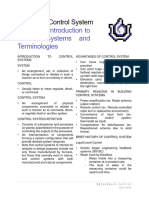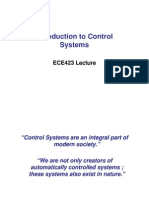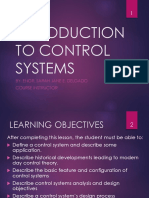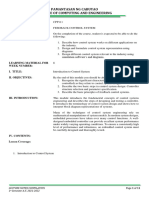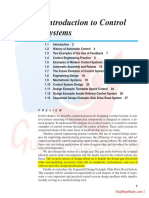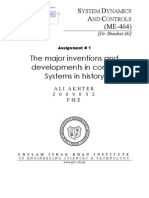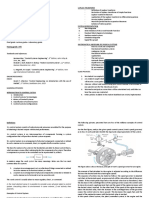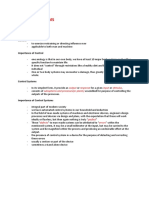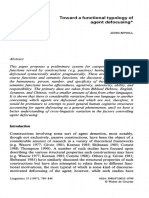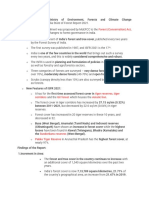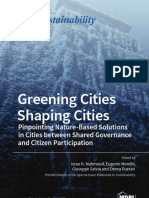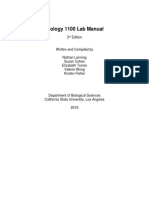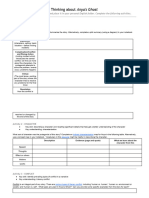Topic1 Part 1 Me4204
Uploaded by
19jclatozaTopic1 Part 1 Me4204
Uploaded by
19jclatozaECE 425
CONTROL SYSTEMS
INTRODUCTION
OBJECTIVES
◆ Possess a basic understanding of control system engineering
◆Be able to recount a brief history of control systems and their role
in society.
◆ Define control system
◆ Discuss advantages of control system
◆ Discuss Open-loop and closed-loop control systems
◆ Discuss Feedback
◆ Discuss Characteristics of feedback.
◆ Define Analog and digital control systems
Introduction
• Engineering is concerned with understanding and controlling the
materials and forces of nature for the benefit of humankind.
• Control system engineers are concerned with understanding and
controlling segments of their environment, often called systems, to
provide useful economic products for society.
• The twin goals of understanding and controlling are complementary
because effective systems control requires that the systems be
understood and modeled.
Introduction
The present challenge to control engineers is
• the modeling and control of modern, complex, interrelated systems
such as traffic control systems, chemical processes, and robotic
systems.
• Simultaneously, the fortunate engineer has the opportunity to control
many useful and interesting industrial automation systems.
• the most characteristic quality of control engineering is the opportunity
to control machines and industrial and economic processes for the
benefit of society.
Introduction
• Control engineering is based on the foundations of feedback theory
and linear system analysis, and it integrates the concepts of network
theory and communication theory.
• Therefore control engineering is not limited to any engineering discipline
but is equally applicable to aeronautical, chemical, mechanical,
environmental, civil, and electrical/electronics engineering.
Introduction
HISTORY CONTROL
Introduction
HISTORY CONTROL
❑ One of the earliest control systems known is the water clock invented by
Ktesibios (300 BC)-Liquid level control.
❑ In 1681, Denis Papin introduced the steam pressure control systems, where he
invented the safety valve (very similar to the present pressure cooker).
❑ In 17th century, hatching eggs using mechanical temperature control
❑ In 1745, speed of windmills are controlled
❑ Pitching blades further back so less area available
As wind decreases, more blade area available
❑ In 1868, James Maxwell published the stability criterion for a 3rd order system
based on the coefficients of differential equations
❑ In 1877, Routh Hurwitz criterion to determine the stability of a system is
proposed
Introduction
HISTORY CONTROL
• The first applications of feedback control appeared in the development of float
regulator mechanisms in Greece in the period 300 to 1 B.C.
• The water clock of Ktesibios used a float regulator (refer to fig. PI.11).
• An oil lamp devised by Philon in approximately 250 B.C. used a float regulator in
an oil lamp for maintaining a constant level of fuel oil. Heron of Alexandria, who
lived in the first century A.D., published a book entitled Pneumatics, which outlined
several forms of water-level mechanisms using float regulators.
Introduction
Introduction
• The first feedback system to be invented in modern Europe was the temperature
regulator of Cornelis Drebbel (1572-1633) of Holland .
• Dennis Papin (1647-1712) invented the first pressure regulator for steam boilers in
1681. Papin’s pressure regulator was a form of safety regulator similar to a
pressure-cooker valve
• The first automatic feedback controller used in an industrial process is generally
agreed to be by James Watt's flyball governor, developed in 1769 for controlling
the speed of a steam engine.
Introduction
Introduction
• The first historical feedback system, claimed by Russia, is the water-level float
regulator said to have been invented by I. Polzunov in 1765.
• In 1868, J. C. Maxwell formulated a mathematical theory related to control theory
using a differential equation model of a governor . Maxwell's study was concerned
with the effect various system parameters had on the system performance.
• During the same period, I. A. Vyshnegradskii formulated a mathematical theory of
regulators .
• Prior to World War II, control theory and practice developed differently in the
United States and western Europe than in Russia and eastern Europe. The main
impetus for the use of feedback in the United States was the development of the
telephone system and electronic feedback amplifiers by Bode, Nyquist, and Black
at Bell Telephone Laboratories
Introduction
• Harold S. Black graduated from Worcester Polytechnic Institute in 1921 and joined
Bell Laboratories of American Telegraph and Telephone (AT&T).
• In 1921, the major task confronting Bell Laboratories was the improvement of the
telephone system and the design of improved signal amplifiers. Black was assigned
the task of linearizing, stabilizing, and improving the amplifiers that were used in
tandem to carry conversations over distances of several thousand miles.
• After considerable effort, an engineering model was delivered for testing to the U.S.
Army on December 1, 1941. Production models were available by early 1943, and
eventually 300() gun controllers were delivered. Input to the controller was provided
by radar, and the gun was aimed by taking the data of the airplane's present
position and calculating the target's future position.
Introduction
• Frequency-domain techniques continued to dominate the field of control following
World War II with the increased use of the Laplace transform and the complex
frequency plane.
• During the 1950s, the emphasis in control engineering theory was on the
development and use of the s-plane methods and, particularly, the root locus
approach.
• during the 1980s, the use of digital computers for control components became
routine. The technology of these new control elements to perform accurate and
rapid calculations was formerly unavailable to control engineers. There are now over
400,000 digital process control computers installed in the United States.
Introduction
• With the advent of Sputnik and the space age, another new impetus was imparted to
control engineering. It became necessary to design complex, highly accurate control
systems for missiles and space probes.
• Furthermore, the necessity to minimize the weight of satellites and to control them
very accurately has spawned the important field of optimal control. Due to these
requirements, the time-domain methods developed by Liapunov, Minorsky, and
others have been met with great interest in the last two decades
• Recent theories of optimal control developed by L. S. Pontryagin in the former
Soviet Union and R. Bellman in the United States, as well as recent studies of
robust systems, have contributed to the interest in time-domain methods.
• It now is clear that control engineering must consider both the time-domain and
the frequency domain approaches simultaneously in the analysis and design of
control systems.
Introduction
• A notable recent advance with worldwide impact is the U.S. space-based radio
navigation system known as the Global Positioning System or GPS
• Research and development culminated in the1990s with 24 navigation satellites
(known as the GPS) that solved the fundamental problem that explorers faced for
centuries by providing a dependable mechanism to pinpoint the current location.
Introduction
Introduction
Introduction
CONTROL SYSTEMS: WHAT THEY ARE
Definition 1.1: A system is an arrangement, set, or collection of things
connected or related in such a manner as to form an entirety or whole.
Definition 1.lb: A system is an arrangement of physical components
connected or related in such a manner as to form and/or act as an
entire unit.
Control - usually taken to mean regulate, direct, or command
Introduction
Definition 2.2: A control system is an arrangement of physical components
connected or related in such a manner as to command, direct, or regulate
itself or another system.
In the most abstract sense it is possible to consider every physical object a
control system. Everything alters its environment in some manner, if not
actively then passively.
Introduction
ADVANTAGES OF CONTROL SYSTEMS
We build control systems for four primary reasons:
1. Power amplification
2. Remote control
3.Convenience of input form
4. Compensation for disturbances
Introduction
Example1: a mirror directing a beam of light shining on it at some acute angle
The mirror (Fig. 1-1) may be considered an elementary control system, controlling the beam of light
according to the simple equation “the angle of reflection a equals the angle of incidence a.”
Introduction
• In engineering and science we usually restrict the meaning of control systems
to apply to those systems whose major function is to dynamically or actively
command, direct, or regulate.
Example 2:
The system shown in Fig. 1-2, consisting of a
mirror pivoted at one end and adjusted up
and down with a screw at the other end, is
properly termed a control system. The angle
of reflected light is regulated by means of
the screw.
Introduction
Definition 1.3:The input is the stimulus, excitation or command applied to
a control system, typically from an external energy source, usually in order
to produce a specified response from the control system.
Definition 1.4: The output is the actual response obtained from a control
system. It may or may not be equal to the specified response implied by
the input.
1.2 EXAMPLES OF CONTROL SYSTEMS
• Inputs and outputs can have many different forms. Inputs, for
example, may be physical variables, or more abstract quantities such
as reference, setpoint, or desired values for the output of the control
system.
• The purpose of the control system usually identifies or defines the
output and input. If the output and input are given, it is possible to
identify, delineate, or define the nature of the system components.
1.2 EXAMPLES OF CONTROL SYSTEMS
• Control systems may have more than one input or output. Often all
inputs and outputs are well defined by the system description. But
sometimes they are not.
Example:
An atmospheric electrical storm may intermittently interfere with radio reception,
producing an unwanted output from a loudspeaker in the form of static. This
“noise” output is part of the total output as defined above, but for the purpose of
simply identifying a system, spurious inputs producing undesirable outputs are not
normally considered as inputs and outputs in the system description.
1.2 EXAMPLES OF CONTROL SYSTEMS
• A control system may be part of a larger system, in which case it is
called a subsystem or control subsystem, and its inputs and outputs
may then be internal variables of the larger system.
EXAMPLE 1.1. An electric switch is a manufactured control system, controlling the
flow of electricity. By definition, the apparatus or person flipping the switch is not a
part of this control system.
• Flipping the switch on or off may be considered as the input. That is, the input can
be in one of two states, on or off.
• The output is the flow or nonflow (two states) of electricity.
The electric switch is one of the most rudimentary control systems.
1.2 EXAMPLES OF CONTROL SYSTEMS
EXAMPLE 1.2. A thermostatically controlled heater or furnace automatically regulating
the temperature of a room or enclosure is a control system.
• The input to this system is a reference temperature, usually specified by
appropriately setting a thermostat.
• The output is the actual temperature of the room or enclosure.
• When the thermostat detects that the output is less than the input, the furnace
provides heat until the temperature of the enclosure becomes equal to the reference
input. Then the furnace is automatically turned off.
• When the temperature falls somewhat below the reference temperature, the furnace
is turned on again
1.2 EXAMPLES OF CONTROL SYSTEMS
EXAMPLE 1.3. The seemingly simple act of pointing at an object with a
finger requires a biological control system consisting chiefly of the eyes,
the arm, hand and finger, and the brain.
• The input is the precise direction of the object (moving or not) with
respect to some reference, and the output is the actual pointed
direction with respect to the same reference.
1.2 EXAMPLES OF CONTROL SYSTEMS
EXAMPLE 1.4. A part of the human temperature control system is the
perspiration system. When the temperature of the air exterior to the skin
becomes too high the sweat glands secrete heavily, inducing cooling of
the skin by evaporation. Secretions are reduced when the desired cooling
effect is achieved, or when the air temperature falls sufficiently.
What do you think is the input ? output?
1.2 EXAMPLES OF CONTROL SYSTEMS
EXAMPLE 1.5. The control system consisting of a person driving an
automobile has components which are clearly both manufactured and
biological. The driver wants to keep the automobile in the appropriate
lane of the roadway.
He or she accomplishes this by constantly watching the direction of the
automobile with respect to the direction of the road.
What do you think is the input? output?
Exercises
Prob.1.1. Identify the input and output for the pivoted, adjustable
mirror of Fig. 1-2.
Exercises
Prob. 1.2. Identify a possible input and a possible output for a rotational
generator of electricity.
Prob. 1.3. Identify the input and output for an automatic washing machine.
Prob1.4. Identify the organ-system components, and the input and output,
and describe the operation of the biological control system consisting of a
human being reaching for an object.
REFERENCES
1. Modern Control Systems 12th Edition by Richard C. Dorf/Robert H.
Bishop
2. Control system by Distefano
3. Control system Engineering by Nise
Supplementary videos
1. https://www.youtube.com/watch?v=GZDPMTBCbYA
2. https://www.youtube.com/watch?v=G9t3ddvBkYU
You might also like
- CUADTM404 405 Teach Basic Jazz and Contemporary Tech Booklet UPDAED VERSION 2023No ratings yetCUADTM404 405 Teach Basic Jazz and Contemporary Tech Booklet UPDAED VERSION 202338 pages
- 1 - Introduction To Control Chapter OneNo ratings yet1 - Introduction To Control Chapter One13 pages
- Application of Laplace Transform in ControlsNo ratings yetApplication of Laplace Transform in Controls31 pages
- 1 - EN - MIA - O2.3 - Exp Course 6 - Course Material - Part 1No ratings yet1 - EN - MIA - O2.3 - Exp Course 6 - Course Material - Part 119 pages
- Mod1Lesson1_Introduction_to_feedback235No ratings yetMod1Lesson1_Introduction_to_feedback23513 pages
- Introduction To Control Systems: Ece-FcsNo ratings yetIntroduction To Control Systems: Ece-Fcs71 pages
- Overview and History of Feedback ControlNo ratings yetOverview and History of Feedback Control4 pages
- 1.1 Definition and History of Feedback and Control Systems Group 1No ratings yet1.1 Definition and History of Feedback and Control Systems Group 116 pages
- RALPH JAN AQUINO Control System SummaryNo ratings yetRALPH JAN AQUINO Control System Summary13 pages
- A Brief History of Feedback Control Lewis PDF100% (1)A Brief History of Feedback Control Lewis PDF19 pages
- A Brief History of Feedback Control - LewisNo ratings yetA Brief History of Feedback Control - Lewis19 pages
- Introduction To Control Systems: Theme 1No ratings yetIntroduction To Control Systems: Theme 116 pages
- AUTO506 Lecture 2 History of Control Systems EngineeringNo ratings yetAUTO506 Lecture 2 History of Control Systems Engineering8 pages
- MEM 355 Performance Enhancement of Dynamical Systems: Introduction To Control System DesignNo ratings yetMEM 355 Performance Enhancement of Dynamical Systems: Introduction To Control System Design26 pages
- System Dynamics and Control: Unggul WasiwitonoNo ratings yetSystem Dynamics and Control: Unggul Wasiwitono26 pages
- A History of Control Engineering 1800-1930 by S. BennettNo ratings yetA History of Control Engineering 1800-1930 by S. Bennett227 pages
- Control Systems - Classical Controls (Patrick Anderson) (Z-Library)No ratings yetControl Systems - Classical Controls (Patrick Anderson) (Z-Library)171 pages
- Module 1 Introduction and Definition of Control SystemNo ratings yetModule 1 Introduction and Definition of Control System27 pages
- Toward A Functional Typology of Agent DefocusingNo ratings yetToward A Functional Typology of Agent Defocusing46 pages
- ENGLISH-Grade 9: Answer Sheet Conditionals No. 1No ratings yetENGLISH-Grade 9: Answer Sheet Conditionals No. 14 pages
- Tamil Nadu General Academic Seat Matrix 2024No ratings yetTamil Nadu General Academic Seat Matrix 2024315 pages
- Economics Is Everywhere 4th Edition by Daniel Hamermesh All Chapter Instant Download100% (7)Economics Is Everywhere 4th Edition by Daniel Hamermesh All Chapter Instant Download34 pages
- Pullout Strength of Hardened Concrete: Standard Test Method For100% (1)Pullout Strength of Hardened Concrete: Standard Test Method For10 pages
- Keragaman Dan Analisis Kekerabatan 30 Jenis Begonia Berdasarkan Karakter MorfologiNo ratings yetKeragaman Dan Analisis Kekerabatan 30 Jenis Begonia Berdasarkan Karakter Morfologi13 pages
- Jss Academy of Technical Education: Department of Electrical & Electronics Engineering0% (1)Jss Academy of Technical Education: Department of Electrical & Electronics Engineering11 pages
- The Continuously Evolving Glove Knitting MachineNo ratings yetThe Continuously Evolving Glove Knitting Machine2 pages
- 100 Ways To Improve Your Lubrication Program100% (1)100 Ways To Improve Your Lubrication Program29 pages
- The Robustness of Parametricb Statistical MethodsNo ratings yetThe Robustness of Parametricb Statistical Methods34 pages
- Class VI(Chapter 3 -Formulas and Function in Excel 2016)No ratings yetClass VI(Chapter 3 -Formulas and Function in Excel 2016)2 pages






